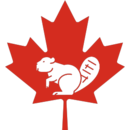| Part of a series on |
| Canadian wildlife |
|---|
 |

The wildlife of Canada or biodiversity of Canada consist of over 80,000 classified species,[a] and an equal number thought yet to be recognized.[3] Known fauna and flora have been identified from five kingdoms:[4] protozoa represent approximately 1% of recorded species; chromist (approximately 4); fungis (approximately 16%); plants (approximately 11%); and animals (approximately 68%).[2][1] Insects account for nearly 70 percent of documented animal species in Canada.[2] More than 300 species are found exclusively in Canada.[5]
There are 20 major ecosystems – ecozones – in Canada: 15 terrestrial and 5 marine.[6] Canada's major biomes are the tundra, boreal forest, grassland, and temperate deciduous forest. Since the end of the last glacial period, Canada has consisted of eight distinct forest regions,[7] with approximately half of its land area covered by forests (roughly 8 percent of the world's forested land).[8]
Due to human activities, invasive species and environmental issues in the country,[9] there are currently more than 800 species at risk of being lost.[10] About 65 percent of Canada's resident species are considered secure.[4] Protected and conservation areas have been established to preserve and restore Canadian flora and fauna species.[11] Approximately 5000 Canadian animal species and 30,000 Canadian plant species are restricted from export for international trade.[12]
- ^ a b Andrea Olive (2019). The Canadian Environment in Political Context, Second Edition. University of Toronto Press, Higher Education Division. p. 36. ISBN 978-1-4875-7037-8.
- ^ a b c "Wild Species 2015: The General Status of Species in Canada" (PDF). National General Status Working Group: 1. Canadian Endangered Species Conservation Council. 2016. p. 2.
- ^ Cite error: The named reference
Animalswas invoked but never defined (see the help page). - ^ a b "Wild Species 2000: The General Status of Species in Canada". Minister of Public Works and Government Services Canada. Conservation Council (CESCC). 2001.
- ^ Hayward, Abi (2020-06-05). "Ours to save: the species that can only be found in Canada". Canadian Geographic. Retrieved 2023-04-12.
- ^ Government of Canada, Statistics Canada (2018-01-10). "Introduction to the Ecological Land Classification (ELC) 2017". www.statcan.gc.ca. Retrieved 2020-11-09.
- ^ National Atlas of Canada. Natural Resources Canada. 2005. p. 1. ISBN 978-0-7705-1198-2.
- ^ Luckert, Martin K.; Haley, David; Hoberg, George (2012). Policies for Sustainably Managing Canada's Forests: Tenure, Stumpage Fees, and Forest Practices. UBC Press. p. 1. ISBN 978-0-7748-2069-1.
- ^ "Biodiversity in Canada: Commitments and Trends". Committee on the Status of Endangered Wildlife in Canada - The Office of the Auditor General of Canada. 2022-10-04. Retrieved 2023-04-09.
- ^ "COSEWIC Annual Report". Species at Risk Public Registry. 2019.
- ^ "What Are Protected Areas?". Nature Canada. 2022-04-13. Retrieved 2023-04-12.
- ^ Canada, Environment and Climate Change (May 19, 2017). "Endangered species list". aem.
Cite error: There are <ref group=lower-alpha> tags or {{efn}} templates on this page, but the references will not show without a {{reflist|group=lower-alpha}} template or {{notelist}} template (see the help page).
© MMXXIII Rich X Search. We shall prevail. All rights reserved. Rich X Search
